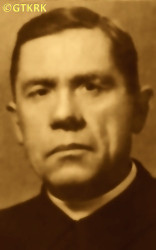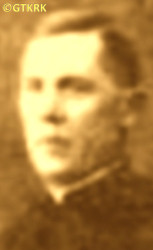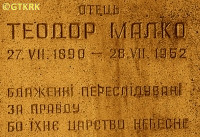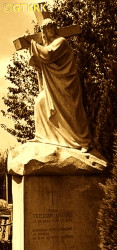Roman Catholic
St Sigismund parish
05-507 Słomczyn
85 Wiślana Str.
Konstancin deanery
Warsaw archdiocese, Poland
full list:
displayClick to display full list

searchClick to search full list by categories
wyświetlKliknij by wyświetlić pełną listę po polsku

szukajKliknij by przeszukać listę wg kategorii po polsku

Martyrology of the clergy — Poland
XX century (1914 – 1989)
personal data
surname
MAŁKO
forename(s)
Theodore (pl. Teodor)
function
eparchial priest
creed
Ukrainian Greek Catholic GCmore on
en.wikipedia.org
[access: 2013.05.19]
diocese / province
Przemyśl GC eparchymore on
pl.wikipedia.org
[access: 2013.05.19]
nationality
Ukrainian
date and place
of death
28.07.1952

Zdolbunivtoday: Zdolbuniv hrom., Rivne rai., Rivne obl., Ukraine
more on
en.wikipedia.org
[access: 2021.09.17]
details of death
After the end of military hostilities of the World War II, started by German and Russian invasion of Poland in 09., after start in 1944 of another Russian occupation, refused in 1945 to sign so‐called „initiative group” manifesto, advocating incorporation of Greek Catholic Church into Russian Orthodox Church (that materialized during so‐called Lviv pseudo–council on 08‐10.03.1946 when Russians formally „liquidated” Greek Catholic Church robbing it of its possessions and passing it to Orthodox Church).
On 20.06.1947 Russian authorities shut down his church in Berezets and fobid him to fulfill priestly duties.
Despite that till 1950 secretly conducted services in a special chapel in the attic of his house.
Finally on 03.11.1950 arrested by agents of MGB (successor of NKVD organization) from Drohobych oblast (warned off attempted to flee with his wife during the night but was apprehended in the Buchaly village n. Komarno).
Held in Komarno, Stryi, Zhydchiv and finally in Drohobych prison.
Accused of, among others, that „being hostile to the Russian authorities led in 1946 funeral services of dead bandits, read the pamphlets of OUN (responsible for the Volyn genocide), and subsequently burned them.
In his home led the illegal Catholic religion rituals and conducted counter–revolutionaryagitation.
Received and distributed nationalist literature”.
On 21.01.1951 sentenced by a Russian court from Drohobych to 10 years of slave labour in Russian concentration camps Gulag.
Held in transit camp TV–167 in Zdolbuniv where was forced to do physical slave work and where perished.
cause of death
extermination
perpetrators
Russians
sites and events
GulagClick to display the description, Drohobych (prisons)Click to display the description, Ribbentrop‐MolotovClick to display the description, Pius XI's encyclicalsClick to display the description
date and place
of birth
27.07.1890

Vanivtoday: Belz urban hrom., Sheptytskyi rai., Lviv obl., Ukraine
more on
uk.wikipedia.org
[access: 2022.08.05]
parents
MAŁKO Basil
🞲 ?, ? — 🕆 1938, ?

Anne
🞲 ?, ? — 🕆 1934, ?
presbyter (holy orders)
ordination
30.05.1920

Przemyśltoday: Przemyśl city pov., Subcarpathia voiv., Poland
more on
en.wikipedia.org
[access: 2021.04.01]
St Therese GC cathedral churchmore on
en.wikipedia.org
[access: 2025.03.14]
positions held
1947 – 1950
priest — Berezetstoday: Komarno urban hrom., Lviv rai., Lviv obl., Ukraine
more on
uk.wikipedia.org
[access: 2022.11.20] ⋄ Sacred Heart of Jesus GC parish ⋄ Komarnotoday: Komarno urban hrom., Lviv rai., Lviv obl., Ukraine
more on
en.wikipedia.org
[access: 2021.12.19] GC deanery
1944 – 1947
parish priest — Berezetstoday: Komarno urban hrom., Lviv rai., Lviv obl., Ukraine
more on
uk.wikipedia.org
[access: 2022.11.20] ⋄ Sacred Heart of Jesus GC parish ⋄ Komarnotoday: Komarno urban hrom., Lviv rai., Lviv obl., Ukraine
more on
en.wikipedia.org
[access: 2021.12.19] GC deanery
1939 – 1944
administrator — Wolicatoday: Bukowsko gm., Sanok pov., Subcarpathia voiv., Poland
more on
en.wikipedia.org
[access: 2022.01.22] ⋄ St Peter and St Paul the Apostles GC parish ⋄ Bukowskotoday: Bukowsko gm., Sanok pov., Subcarpathia voiv., Poland
more on
en.wikipedia.org
[access: 2021.10.09] GC deanery
1934 – 1939
parish priest — Kolodnotoday: Velyke Kolodno, Zhovtantsi hrom., Lviv rai., Lviv obl., Ukraine
more on
uk.wikipedia.org
[access: 2022.08.05] ⋄ Exaltation of the Holy Cross GC parish ⋄ Kulykivtoday: Kulykiv hrom., Lviv rai., Lviv obl., Ukraine
more on
en.wikipedia.org
[access: 2022.01.22] GC deanery
1931 – 1934
dean — Bukowskotoday: Bukowsko gm., Sanok pov., Subcarpathia voiv., Poland
more on
en.wikipedia.org
[access: 2021.10.09] GC deanery
1929 – 1931
deputy dean — Bukowskotoday: Bukowsko gm., Sanok pov., Subcarpathia voiv., Poland
more on
en.wikipedia.org
[access: 2021.10.09] GC deanery
1927 – 1934
parish priest — Wolicatoday: Bukowsko gm., Sanok pov., Subcarpathia voiv., Poland
more on
en.wikipedia.org
[access: 2022.01.22] ⋄ St Peter and St Paul the Apostles GC parish ⋄ Bukowskotoday: Bukowsko gm., Sanok pov., Subcarpathia voiv., Poland
more on
en.wikipedia.org
[access: 2021.10.09] GC deanery
1926
administrator — Średnie Wielkietoday: Zagórz gm., Sanok pov., Subcarpathia voiv., Poland
more on
en.wikipedia.org
[access: 2022.01.16] ⋄ St Paraskeva Pyatnitsa GC parish ⋄ Leskotoday: Lesko gm., Lesko pov., Subcarpathia voiv., Poland
more on
en.wikipedia.org
[access: 2021.10.09] GC deanery
1926
administrator — Manasterzectoday: Lesko gm., Lesko pov., Subcarpathia voiv., Poland
more on
en.wikipedia.org
[access: 2022.01.16] ⋄ Transfiguration of the Lord GC parish ⋄ Leskotoday: Lesko gm., Lesko pov., Subcarpathia voiv., Poland
more on
en.wikipedia.org
[access: 2021.10.09] GC deanery
1921 – 1926
administrator — Łopienkavillage
today: non‐existent, Cisna gm., Lesko pov., Subcarpathia voiv., Poland
more on
pl.wikipedia.org
[access: 2024.03.19] ⋄ St Paraskeva Pyatnitsa GC parish ⋄ Cisnatoday: Cisna gm., Lesko pov., Subcarpathia voiv., Poland
more on
en.wikipedia.org
[access: 2021.10.09] GC deanery
1920 – 1921
administrator — Terkatoday: Solina gm., Lesko pov., Subcarpathia voiv., Poland
more on
en.wikipedia.org
[access: 2021.12.18] ⋄ St Elijah the Prophet GC parish ⋄ Baligródtoday: Baligród gm., Lesko pov., Subcarpathia voiv., Poland
more on
en.wikipedia.org
[access: 2021.10.09] GC deanery
1920
vicar — Serednicatoday: Ustrzyki Dolne gm., Bieszczady pov., Subcarpathia voiv., Poland
more on
en.wikipedia.org
[access: 2022.01.16] ⋄ Intercession of the Our Lady of Sorrows GC parish ⋄ Leskotoday: Lesko gm., Lesko pov., Subcarpathia voiv., Poland
more on
en.wikipedia.org
[access: 2021.10.09] GC deanery
till 1917
student — Przemyśltoday: Przemyśl city pov., Subcarpathia voiv., Poland
more on
en.wikipedia.org
[access: 2021.04.01] ⋄ philosophy and theology, Greek Catholic Theological Seminary
1912 – 1914
student — Lvivtoday: Lviv urban hrom., Lviv rai., Lviv obl., Ukraine
more on
en.wikipedia.org
[access: 2022.01.16] ⋄ philosophy and theology, Greek Catholic Theological Seminary
married — five children
sites and events
descriptions
Gulag: The acronym Gulag comes from the Rus. Главное управление исправительно‐трудовых лагерей и колоний (Eng. Main Board of Correctional Labor Camps). The network of Russian concentration camps for slave labor was formally established by the decision of the highest Russian authorities on 27.06.1929. Control was taken over by the OGPU, the predecessor of the genocidal NKVD (from 1934) and the MGB (from 1946). Individual gulags (camps) were often established in remote, sparsely populated areas, where industrial or transport facilities important for the Russian state were built. They were modeled on the first „great construction of communism”, the White Sea‐Baltic Canal (1931‐1932), and Naftali Frenkel, of Jewish origin, is considered the creator of the system of using forced slave labor within the Gulag. He went down in history as the author of the principle „We have to squeeze everything out of the prisoner in the first three months — then nothing is there for us”. He was to be the creator, according to Alexander Solzhenitsyn, of the so‐called „Boiler system”, i.e. the dependence of food rations on working out a certain percentage of the norm. The term ZEK — prisoner — i.e. Rus. заключенный‐каналоармец (Eng. canal soldier) — was coined in the ITL BelBaltLag managed by him, and was adopted to mean a prisoner in Russian slave labor camps. Up to 12 mln prisoners were held in Gulag camps at one time, i.e. c. 5% of Russia's population. In his book „The Gulag Archipelago”, Solzhenitsyn estimated that c. 60 mln people were killed in the Gulag until 1956. Formally dissolved on 20.01.1960. (more on: en.wikipedia.orgClick to attempt to display webpage
[access: 2024.04.08])
Drohobych (prisons): Before the outbreak of the World War II in 09.1939 a criminal prison functioned at Drohobych Truskawiecka Str. where c. 1,200‐1,500 inmates were held. After the start in 09.1939 of the first Russian occupation a new jail run by Russian NKVD genocidal organization was opened at Striyska Str. (by regional NKVD headquarters). There in 06.1941, after German attack of their erstwhile ally, Russians, NKVD perpetrated a genocidal massacre of prisoners. After German defeat and start in 1944 of another Russian occupation NKVD returned to the same buildings and again opened their jail, where hundreds and thousands of people suspected of not supporting Russia were held and interrogated. The jail was closed in 1959. The prison at Truskawiecka Str. however remained open throughout the World War II, both during Russian and German occupations, stayed open after the end of military hostilities and operates till today. (more on: btx.home.plClick to attempt to display webpage
[access: 2020.04.04])
Ribbentrop‐Molotov: Genocidal Russian‐German alliance pact between Russian leader Joseph Stalin and German leader Adolf Hitler signed on 23.08.1939 in Moscow by respective foreign ministers, Mr. Vyacheslav Molotov for Russia and Joachim von Ribbentrop for Germany. The pact sanctioned and was the direct cause of joint Russian and German invasion of Poland and the outbreak of the World War II in 09.1939. In a political sense, the pact was an attempt to restore the status quo ante before 1914, with one exception, namely the „commercial” exchange of the so‐called „Kingdom of Poland”, which in 1914 was part of the Russian Empire, fore Eastern Galicia (today's western Ukraine), in 1914 belonging to the Austro‐Hungarian Empire. Galicia, including Lviv, was to be taken over by the Russians, the „Kingdom of Poland” — under the name of the General Governorate — Germany. The resultant „war was one of the greatest calamities and dramas of humanity in history, for two atheistic and anti‐Christian ideologies — national and international socialism — rejected God and His fifth Decalogue commandment: Thou shall not kill!” (Abp Stanislav Gądecki, 01.09.2019). The decisions taken — backed up by the betrayal of the formal allies of Poland, France and Germany, which on 12.09.1939, at a joint conference in Abbeville, decided not to provide aid to attacked Poland and not to take military action against Germany (a clear breach of treaty obligations with Poland) — were on 28.09.1939 slightly altered and made more precise when a treaty on „German‐Russian boundaries and friendship” was agreed by the same murderous signatories. One of its findings was establishment of spheres of influence in Central and Eastern Europe and in consequence IV partition of Poland. In one of its secret annexes agreed, that: „the Signatories will not tolerate on its respective territories any Polish propaganda that affects the territory of the other Side. On their respective territories they will suppress all such propaganda and inform each other of the measures taken to accomplish it”. The agreements resulted in a series of meeting between two genocidal organization representing both sides — German Gestapo and Russian NKVD when coordination of efforts to exterminate Polish intelligentsia and Polish leading classes (in Germany called «Intelligenzaktion», in Russia took the form of Katyń massacres) where discussed. Resulted in deaths of hundreds of thousands of Polish intelligentsia, including thousands of priests presented here, and tens of millions of ordinary people,. The results of this Russian‐German pact lasted till 1989 and are still in evidence even today. (more on: en.wikipedia.orgClick to attempt to display webpage
[access: 2015.09.30])
Pius XI's encyclicals: Facing the creation of two totalitarian systems in Europe, which seemed to compete with each other, though there were more similarities than contradictions between them, Pope Pius XI issued in 03.1937 (within 5 days) two encyclicals. In the „Mit brennender Sorge” (Eng. „With Burning Concern”) published on 14.03.1938, condemned the national socialism prevailing in Germany. The Pope wrote: „Whoever, following the old Germanic‐pre‐Christian beliefs, puts various impersonal fate in the place of a personal God, denies the wisdom of God and Providence […], whoever exalts earthly values: race or nation, or state, or state system, representatives of state power or other fundamental values of human society, […] and makes them the highest standard of all values, including religious ones, and idolizes them, this one […] is far from true faith in God and from a worldview corresponding to such faith”. On 19.03.1937, published „Divini Redemptoris” (Eng. „Divine Redeemer”), in which criticized Russian communism, dialectical materialism and the class struggle theory. The Pope wrote: „Communism deprives man of freedom, and therefore the spiritual basis of all life norms. It deprives the human person of all his dignity and any moral support with which he could resist the onslaught of blind passions […] This is the new gospel that Bolshevik and godless communism preaches as a message of salvation and redemption of humanity”… Pius XI demanded that the established human law be subjected to the natural law of God , recommended the implementation of the ideal of a Christian state and society, and called on Catholics to resist. Two years later, National Socialist Germany and Communist Russia came together and started World War II. (more on: www.vatican.vaClick to attempt to display webpage
[access: 2023.05.28], www.vatican.vaClick to attempt to display webpage
[access: 2023.05.28])
sources
personal:
issuu.comClick to attempt to display webpage
[access: 2020.04.04], www.facebook.comClick to attempt to display webpage
[access: 2020.04.04]
bibliographical:
„Clergy of Przemyśl Eparchy and Apostolic Exarchate of Lemkivshchyna”, Bogdan Prach, Ukrainian Catholic University Publishing House, Lviv 2015
original images:
issuu.comClick to attempt to display webpage
[access: 2020.04.04], www.pslava.infoClick to attempt to display webpage
[access: 2020.04.04], www.pslava.infoClick to attempt to display webpage
[access: 2020.04.04]
LETTER to CUSTODIAN/ADMINISTRATOR
If you have an Email client on your communicator/computer — such as Mozilla Thunderbird, Windows Mail or Microsoft Outlook, described at WikipediaPatrz:
en.wikipedia.org, among others — try the link below, please:
LETTER to CUSTODIAN/ADMINISTRATORClick and try to call your own Email client
If however you do not run such a client or the above link is not active please send an email to the Custodian/Administrator using your account — in your customary email/correspondence engine — at the following address:

giving the following as the subject:
MARTYROLOGY: MAŁKO Theodore
To return to the biography press below:
 Click to return to biography
Click to return to biography











